Australian Corporate Law Reforms and Cases
VerifiedAdded on 2020/05/11
|10
|2858
|54
AI Summary
This assignment delves into the evolution of Australian corporate law, focusing on significant reforms and their influence. It critically examines landmark legal cases like *Barrow v CSR Ltd* and *Briggs v James Hardie& Co Pty Ltd*, alongside academic works by authors such as Beekes et al., Bruner, and Paolella that provide insights into corporate governance, disclosure practices, and the market dynamics within Australian corporate law.
Contribute Materials
Your contribution can guide someone’s learning journey. Share your
documents today.
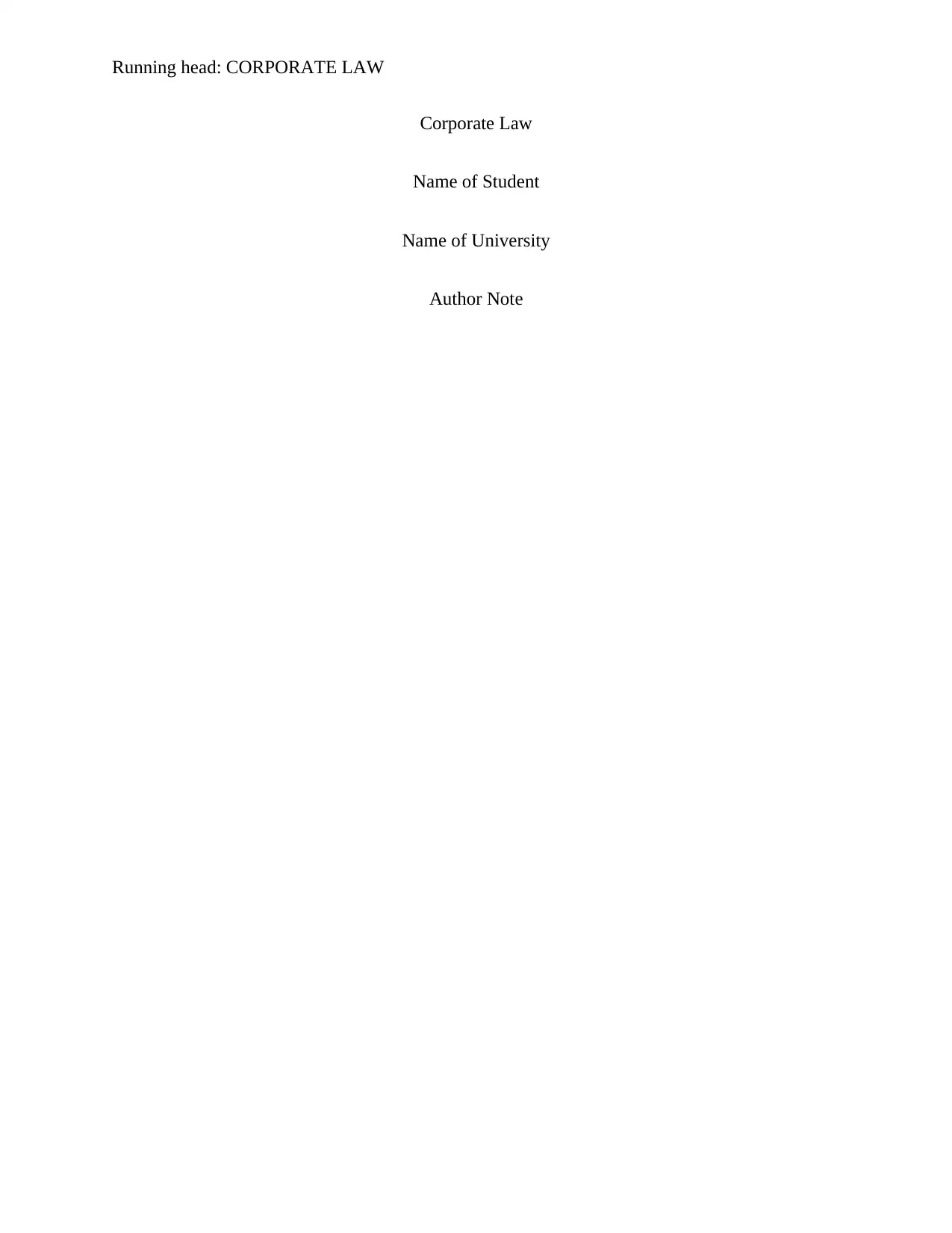
Running head: CORPORATE LAW
Corporate Law
Name of Student
Name of University
Author Note
Corporate Law
Name of Student
Name of University
Author Note
Secure Best Marks with AI Grader
Need help grading? Try our AI Grader for instant feedback on your assignments.
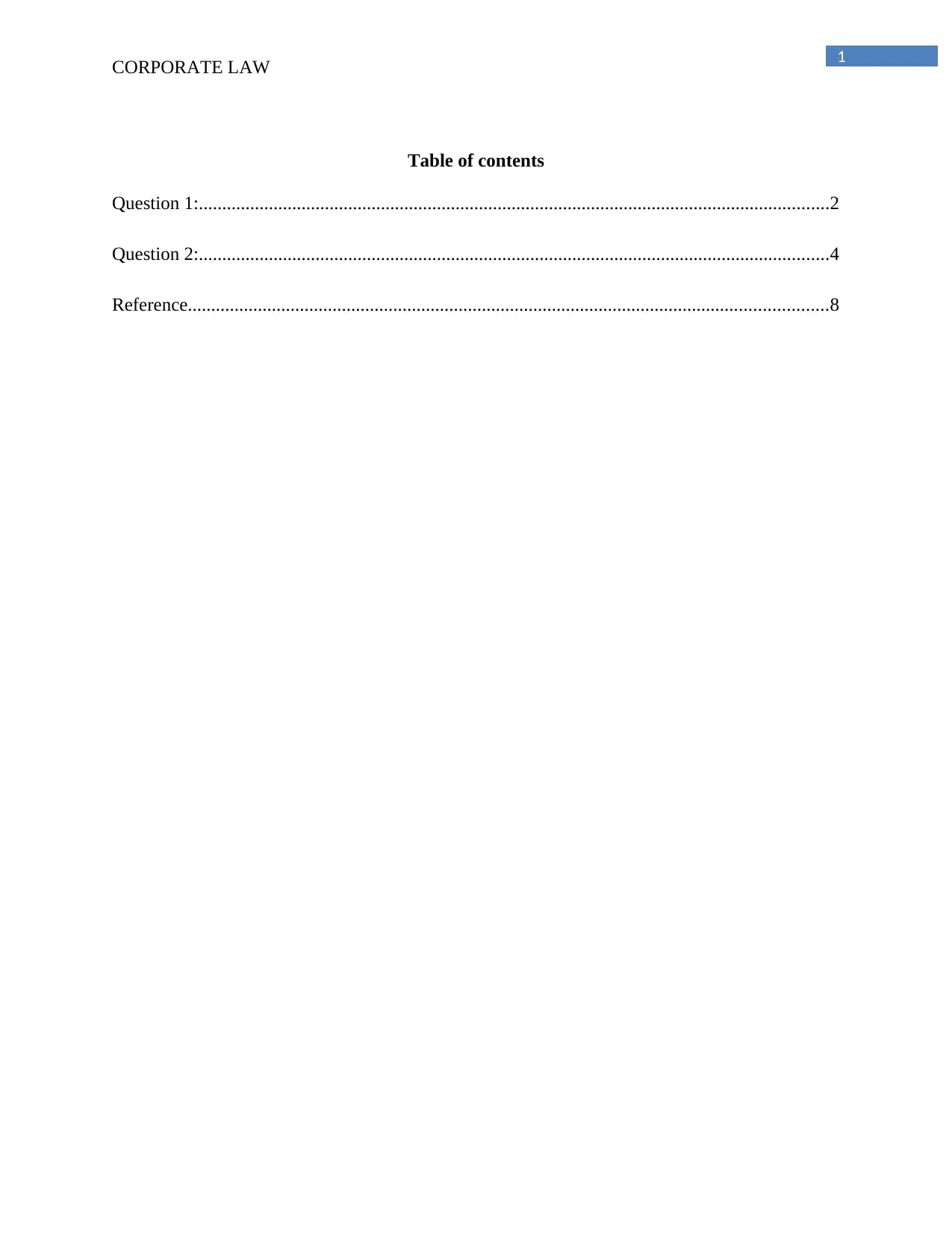
1
CORPORATE LAW
Table of contents
Question 1:.......................................................................................................................................2
Question 2:.......................................................................................................................................4
Reference.........................................................................................................................................8
CORPORATE LAW
Table of contents
Question 1:.......................................................................................................................................2
Question 2:.......................................................................................................................................4
Reference.........................................................................................................................................8
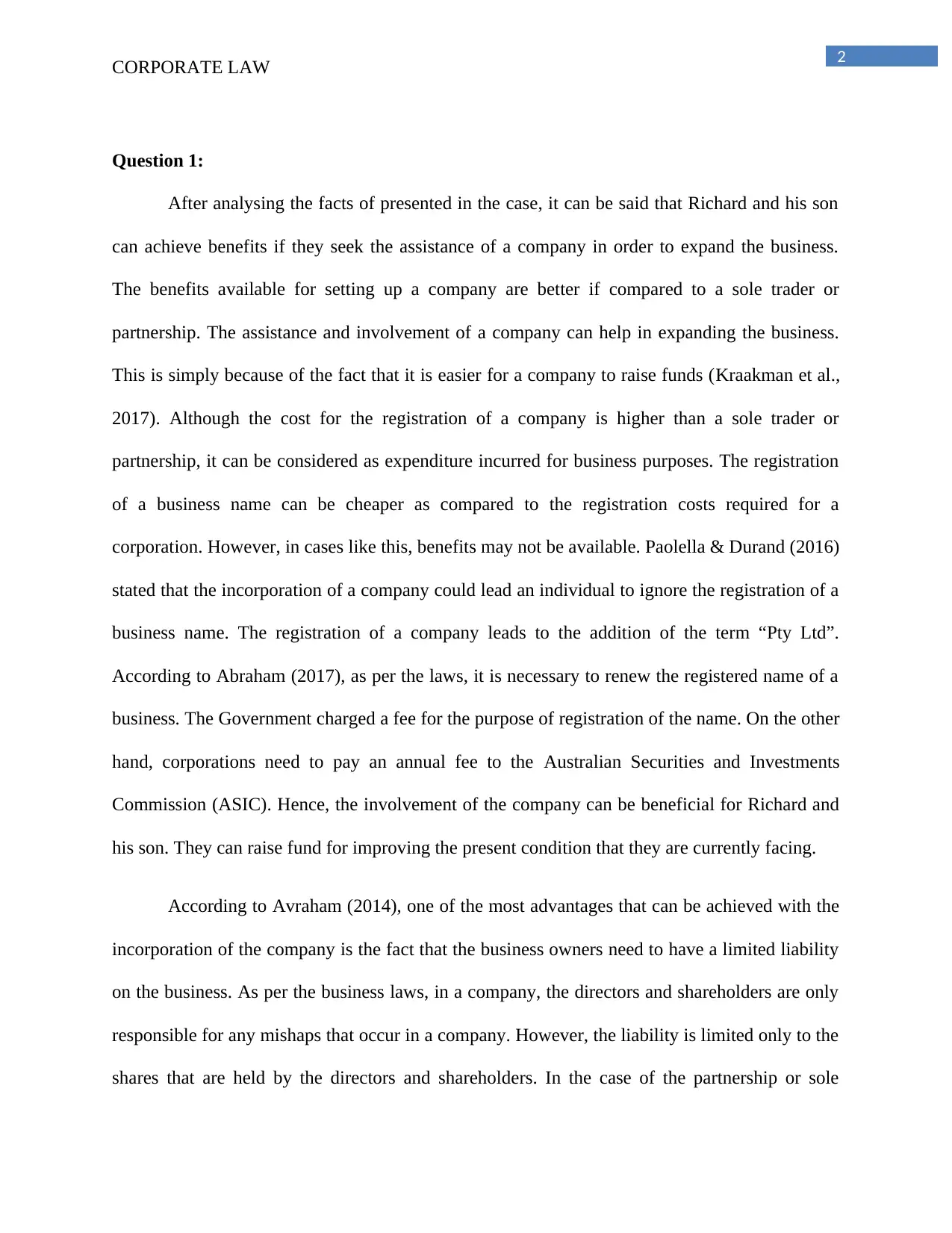
2
CORPORATE LAW
Question 1:
After analysing the facts of presented in the case, it can be said that Richard and his son
can achieve benefits if they seek the assistance of a company in order to expand the business.
The benefits available for setting up a company are better if compared to a sole trader or
partnership. The assistance and involvement of a company can help in expanding the business.
This is simply because of the fact that it is easier for a company to raise funds (Kraakman et al.,
2017). Although the cost for the registration of a company is higher than a sole trader or
partnership, it can be considered as expenditure incurred for business purposes. The registration
of a business name can be cheaper as compared to the registration costs required for a
corporation. However, in cases like this, benefits may not be available. Paolella & Durand (2016)
stated that the incorporation of a company could lead an individual to ignore the registration of a
business name. The registration of a company leads to the addition of the term “Pty Ltd”.
According to Abraham (2017), as per the laws, it is necessary to renew the registered name of a
business. The Government charged a fee for the purpose of registration of the name. On the other
hand, corporations need to pay an annual fee to the Australian Securities and Investments
Commission (ASIC). Hence, the involvement of the company can be beneficial for Richard and
his son. They can raise fund for improving the present condition that they are currently facing.
According to Avraham (2014), one of the most advantages that can be achieved with the
incorporation of the company is the fact that the business owners need to have a limited liability
on the business. As per the business laws, in a company, the directors and shareholders are only
responsible for any mishaps that occur in a company. However, the liability is limited only to the
shares that are held by the directors and shareholders. In the case of the partnership or sole
CORPORATE LAW
Question 1:
After analysing the facts of presented in the case, it can be said that Richard and his son
can achieve benefits if they seek the assistance of a company in order to expand the business.
The benefits available for setting up a company are better if compared to a sole trader or
partnership. The assistance and involvement of a company can help in expanding the business.
This is simply because of the fact that it is easier for a company to raise funds (Kraakman et al.,
2017). Although the cost for the registration of a company is higher than a sole trader or
partnership, it can be considered as expenditure incurred for business purposes. The registration
of a business name can be cheaper as compared to the registration costs required for a
corporation. However, in cases like this, benefits may not be available. Paolella & Durand (2016)
stated that the incorporation of a company could lead an individual to ignore the registration of a
business name. The registration of a company leads to the addition of the term “Pty Ltd”.
According to Abraham (2017), as per the laws, it is necessary to renew the registered name of a
business. The Government charged a fee for the purpose of registration of the name. On the other
hand, corporations need to pay an annual fee to the Australian Securities and Investments
Commission (ASIC). Hence, the involvement of the company can be beneficial for Richard and
his son. They can raise fund for improving the present condition that they are currently facing.
According to Avraham (2014), one of the most advantages that can be achieved with the
incorporation of the company is the fact that the business owners need to have a limited liability
on the business. As per the business laws, in a company, the directors and shareholders are only
responsible for any mishaps that occur in a company. However, the liability is limited only to the
shares that are held by the directors and shareholders. In the case of the partnership or sole
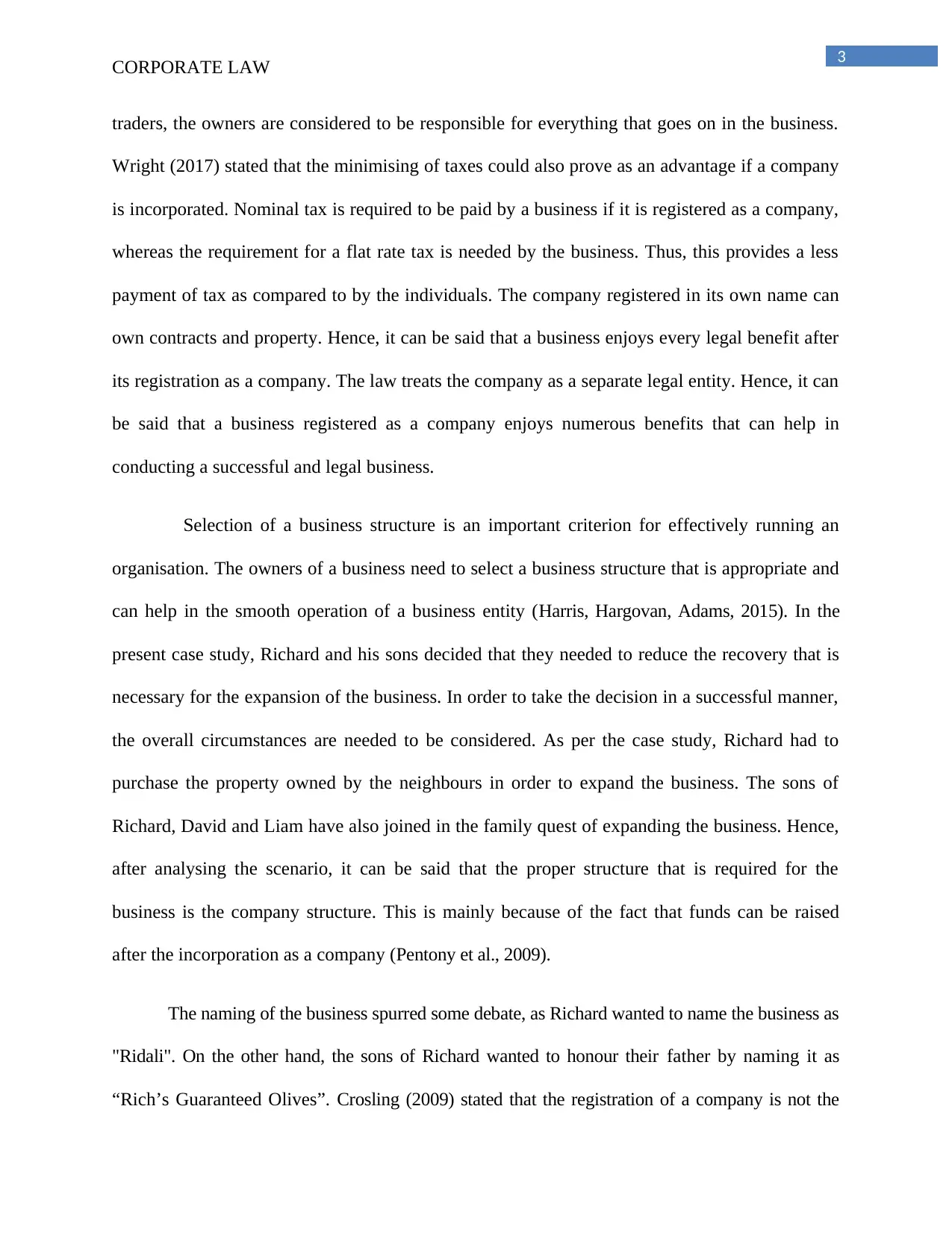
3
CORPORATE LAW
traders, the owners are considered to be responsible for everything that goes on in the business.
Wright (2017) stated that the minimising of taxes could also prove as an advantage if a company
is incorporated. Nominal tax is required to be paid by a business if it is registered as a company,
whereas the requirement for a flat rate tax is needed by the business. Thus, this provides a less
payment of tax as compared to by the individuals. The company registered in its own name can
own contracts and property. Hence, it can be said that a business enjoys every legal benefit after
its registration as a company. The law treats the company as a separate legal entity. Hence, it can
be said that a business registered as a company enjoys numerous benefits that can help in
conducting a successful and legal business.
Selection of a business structure is an important criterion for effectively running an
organisation. The owners of a business need to select a business structure that is appropriate and
can help in the smooth operation of a business entity (Harris, Hargovan, Adams, 2015). In the
present case study, Richard and his sons decided that they needed to reduce the recovery that is
necessary for the expansion of the business. In order to take the decision in a successful manner,
the overall circumstances are needed to be considered. As per the case study, Richard had to
purchase the property owned by the neighbours in order to expand the business. The sons of
Richard, David and Liam have also joined in the family quest of expanding the business. Hence,
after analysing the scenario, it can be said that the proper structure that is required for the
business is the company structure. This is mainly because of the fact that funds can be raised
after the incorporation as a company (Pentony et al., 2009).
The naming of the business spurred some debate, as Richard wanted to name the business as
"Ridali". On the other hand, the sons of Richard wanted to honour their father by naming it as
“Rich’s Guaranteed Olives”. Crosling (2009) stated that the registration of a company is not the
CORPORATE LAW
traders, the owners are considered to be responsible for everything that goes on in the business.
Wright (2017) stated that the minimising of taxes could also prove as an advantage if a company
is incorporated. Nominal tax is required to be paid by a business if it is registered as a company,
whereas the requirement for a flat rate tax is needed by the business. Thus, this provides a less
payment of tax as compared to by the individuals. The company registered in its own name can
own contracts and property. Hence, it can be said that a business enjoys every legal benefit after
its registration as a company. The law treats the company as a separate legal entity. Hence, it can
be said that a business registered as a company enjoys numerous benefits that can help in
conducting a successful and legal business.
Selection of a business structure is an important criterion for effectively running an
organisation. The owners of a business need to select a business structure that is appropriate and
can help in the smooth operation of a business entity (Harris, Hargovan, Adams, 2015). In the
present case study, Richard and his sons decided that they needed to reduce the recovery that is
necessary for the expansion of the business. In order to take the decision in a successful manner,
the overall circumstances are needed to be considered. As per the case study, Richard had to
purchase the property owned by the neighbours in order to expand the business. The sons of
Richard, David and Liam have also joined in the family quest of expanding the business. Hence,
after analysing the scenario, it can be said that the proper structure that is required for the
business is the company structure. This is mainly because of the fact that funds can be raised
after the incorporation as a company (Pentony et al., 2009).
The naming of the business spurred some debate, as Richard wanted to name the business as
"Ridali". On the other hand, the sons of Richard wanted to honour their father by naming it as
“Rich’s Guaranteed Olives”. Crosling (2009) stated that the registration of a company is not the
Secure Best Marks with AI Grader
Need help grading? Try our AI Grader for instant feedback on your assignments.
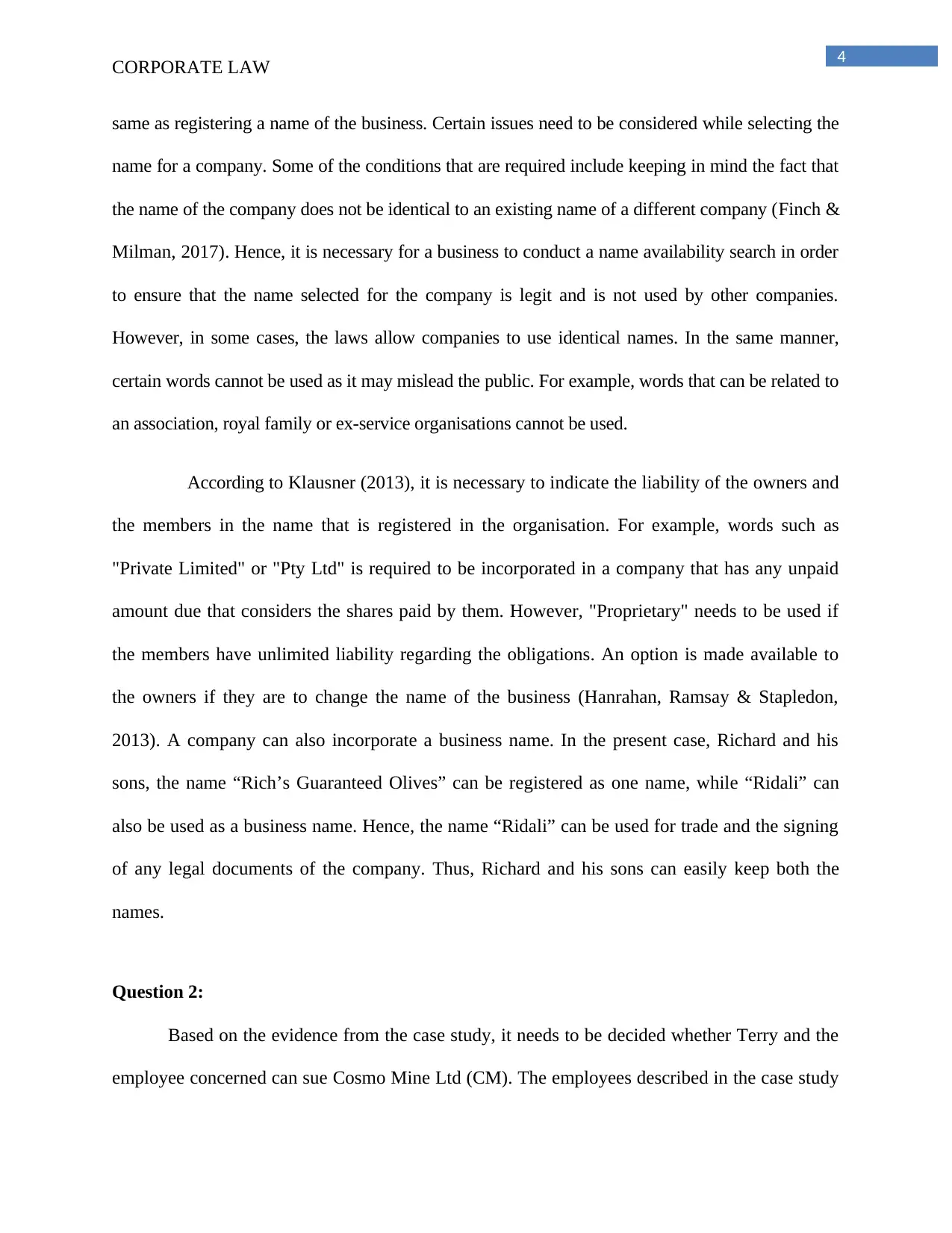
4
CORPORATE LAW
same as registering a name of the business. Certain issues need to be considered while selecting the
name for a company. Some of the conditions that are required include keeping in mind the fact that
the name of the company does not be identical to an existing name of a different company (Finch &
Milman, 2017). Hence, it is necessary for a business to conduct a name availability search in order
to ensure that the name selected for the company is legit and is not used by other companies.
However, in some cases, the laws allow companies to use identical names. In the same manner,
certain words cannot be used as it may mislead the public. For example, words that can be related to
an association, royal family or ex-service organisations cannot be used.
According to Klausner (2013), it is necessary to indicate the liability of the owners and
the members in the name that is registered in the organisation. For example, words such as
"Private Limited" or "Pty Ltd" is required to be incorporated in a company that has any unpaid
amount due that considers the shares paid by them. However, "Proprietary" needs to be used if
the members have unlimited liability regarding the obligations. An option is made available to
the owners if they are to change the name of the business (Hanrahan, Ramsay & Stapledon,
2013). A company can also incorporate a business name. In the present case, Richard and his
sons, the name “Rich’s Guaranteed Olives” can be registered as one name, while “Ridali” can
also be used as a business name. Hence, the name “Ridali” can be used for trade and the signing
of any legal documents of the company. Thus, Richard and his sons can easily keep both the
names.
Question 2:
Based on the evidence from the case study, it needs to be decided whether Terry and the
employee concerned can sue Cosmo Mine Ltd (CM). The employees described in the case study
CORPORATE LAW
same as registering a name of the business. Certain issues need to be considered while selecting the
name for a company. Some of the conditions that are required include keeping in mind the fact that
the name of the company does not be identical to an existing name of a different company (Finch &
Milman, 2017). Hence, it is necessary for a business to conduct a name availability search in order
to ensure that the name selected for the company is legit and is not used by other companies.
However, in some cases, the laws allow companies to use identical names. In the same manner,
certain words cannot be used as it may mislead the public. For example, words that can be related to
an association, royal family or ex-service organisations cannot be used.
According to Klausner (2013), it is necessary to indicate the liability of the owners and
the members in the name that is registered in the organisation. For example, words such as
"Private Limited" or "Pty Ltd" is required to be incorporated in a company that has any unpaid
amount due that considers the shares paid by them. However, "Proprietary" needs to be used if
the members have unlimited liability regarding the obligations. An option is made available to
the owners if they are to change the name of the business (Hanrahan, Ramsay & Stapledon,
2013). A company can also incorporate a business name. In the present case, Richard and his
sons, the name “Rich’s Guaranteed Olives” can be registered as one name, while “Ridali” can
also be used as a business name. Hence, the name “Ridali” can be used for trade and the signing
of any legal documents of the company. Thus, Richard and his sons can easily keep both the
names.
Question 2:
Based on the evidence from the case study, it needs to be decided whether Terry and the
employee concerned can sue Cosmo Mine Ltd (CM). The employees described in the case study
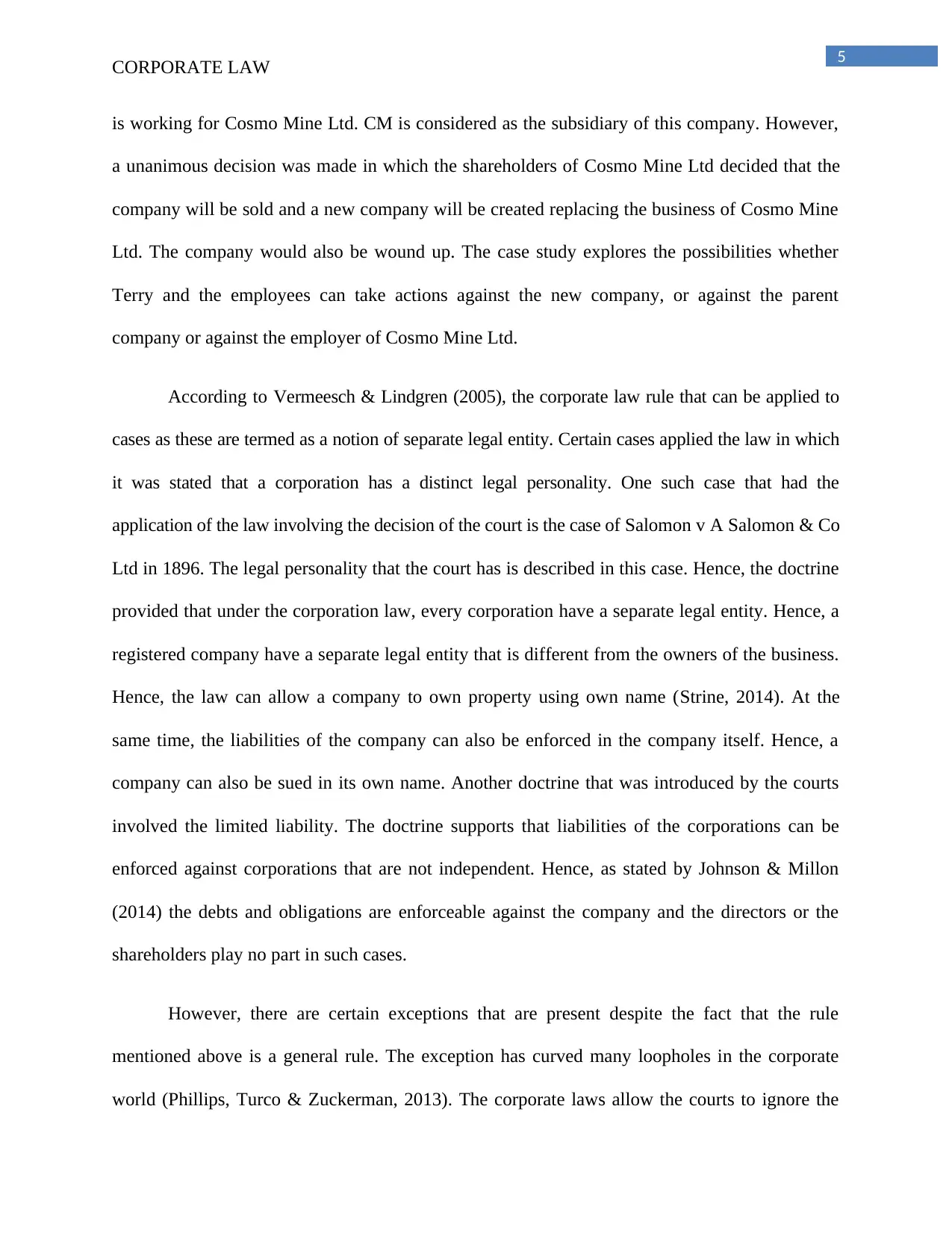
5
CORPORATE LAW
is working for Cosmo Mine Ltd. CM is considered as the subsidiary of this company. However,
a unanimous decision was made in which the shareholders of Cosmo Mine Ltd decided that the
company will be sold and a new company will be created replacing the business of Cosmo Mine
Ltd. The company would also be wound up. The case study explores the possibilities whether
Terry and the employees can take actions against the new company, or against the parent
company or against the employer of Cosmo Mine Ltd.
According to Vermeesch & Lindgren (2005), the corporate law rule that can be applied to
cases as these are termed as a notion of separate legal entity. Certain cases applied the law in which
it was stated that a corporation has a distinct legal personality. One such case that had the
application of the law involving the decision of the court is the case of Salomon v A Salomon & Co
Ltd in 1896. The legal personality that the court has is described in this case. Hence, the doctrine
provided that under the corporation law, every corporation have a separate legal entity. Hence, a
registered company have a separate legal entity that is different from the owners of the business.
Hence, the law can allow a company to own property using own name (Strine, 2014). At the
same time, the liabilities of the company can also be enforced in the company itself. Hence, a
company can also be sued in its own name. Another doctrine that was introduced by the courts
involved the limited liability. The doctrine supports that liabilities of the corporations can be
enforced against corporations that are not independent. Hence, as stated by Johnson & Millon
(2014) the debts and obligations are enforceable against the company and the directors or the
shareholders play no part in such cases.
However, there are certain exceptions that are present despite the fact that the rule
mentioned above is a general rule. The exception has curved many loopholes in the corporate
world (Phillips, Turco & Zuckerman, 2013). The corporate laws allow the courts to ignore the
CORPORATE LAW
is working for Cosmo Mine Ltd. CM is considered as the subsidiary of this company. However,
a unanimous decision was made in which the shareholders of Cosmo Mine Ltd decided that the
company will be sold and a new company will be created replacing the business of Cosmo Mine
Ltd. The company would also be wound up. The case study explores the possibilities whether
Terry and the employees can take actions against the new company, or against the parent
company or against the employer of Cosmo Mine Ltd.
According to Vermeesch & Lindgren (2005), the corporate law rule that can be applied to
cases as these are termed as a notion of separate legal entity. Certain cases applied the law in which
it was stated that a corporation has a distinct legal personality. One such case that had the
application of the law involving the decision of the court is the case of Salomon v A Salomon & Co
Ltd in 1896. The legal personality that the court has is described in this case. Hence, the doctrine
provided that under the corporation law, every corporation have a separate legal entity. Hence, a
registered company have a separate legal entity that is different from the owners of the business.
Hence, the law can allow a company to own property using own name (Strine, 2014). At the
same time, the liabilities of the company can also be enforced in the company itself. Hence, a
company can also be sued in its own name. Another doctrine that was introduced by the courts
involved the limited liability. The doctrine supports that liabilities of the corporations can be
enforced against corporations that are not independent. Hence, as stated by Johnson & Millon
(2014) the debts and obligations are enforceable against the company and the directors or the
shareholders play no part in such cases.
However, there are certain exceptions that are present despite the fact that the rule
mentioned above is a general rule. The exception has curved many loopholes in the corporate
world (Phillips, Turco & Zuckerman, 2013). The corporate laws allow the courts to ignore the
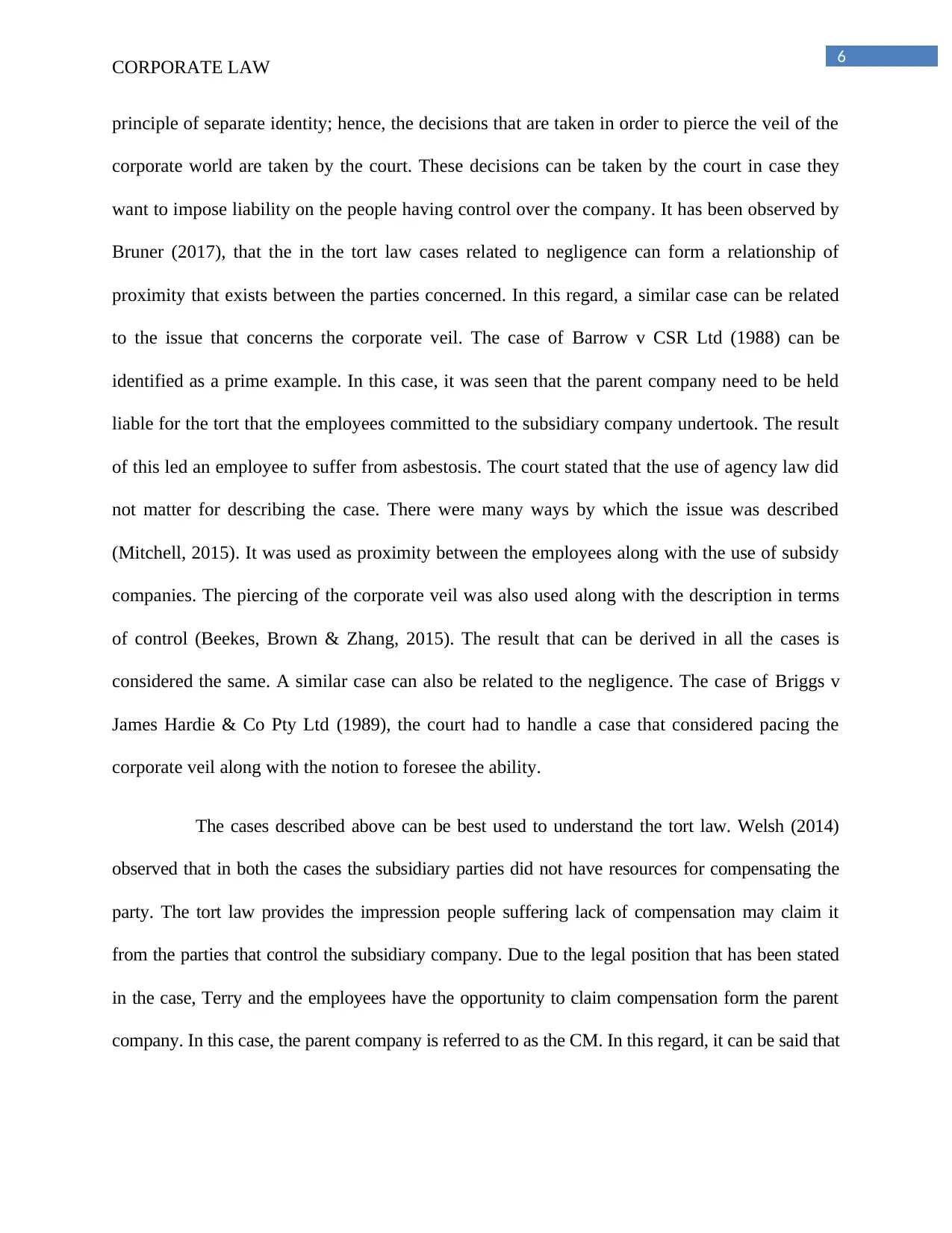
6
CORPORATE LAW
principle of separate identity; hence, the decisions that are taken in order to pierce the veil of the
corporate world are taken by the court. These decisions can be taken by the court in case they
want to impose liability on the people having control over the company. It has been observed by
Bruner (2017), that the in the tort law cases related to negligence can form a relationship of
proximity that exists between the parties concerned. In this regard, a similar case can be related
to the issue that concerns the corporate veil. The case of Barrow v CSR Ltd (1988) can be
identified as a prime example. In this case, it was seen that the parent company need to be held
liable for the tort that the employees committed to the subsidiary company undertook. The result
of this led an employee to suffer from asbestosis. The court stated that the use of agency law did
not matter for describing the case. There were many ways by which the issue was described
(Mitchell, 2015). It was used as proximity between the employees along with the use of subsidy
companies. The piercing of the corporate veil was also used along with the description in terms
of control (Beekes, Brown & Zhang, 2015). The result that can be derived in all the cases is
considered the same. A similar case can also be related to the negligence. The case of Briggs v
James Hardie & Co Pty Ltd (1989), the court had to handle a case that considered pacing the
corporate veil along with the notion to foresee the ability.
The cases described above can be best used to understand the tort law. Welsh (2014)
observed that in both the cases the subsidiary parties did not have resources for compensating the
party. The tort law provides the impression people suffering lack of compensation may claim it
from the parties that control the subsidiary company. Due to the legal position that has been stated
in the case, Terry and the employees have the opportunity to claim compensation form the parent
company. In this case, the parent company is referred to as the CM. In this regard, it can be said that
CORPORATE LAW
principle of separate identity; hence, the decisions that are taken in order to pierce the veil of the
corporate world are taken by the court. These decisions can be taken by the court in case they
want to impose liability on the people having control over the company. It has been observed by
Bruner (2017), that the in the tort law cases related to negligence can form a relationship of
proximity that exists between the parties concerned. In this regard, a similar case can be related
to the issue that concerns the corporate veil. The case of Barrow v CSR Ltd (1988) can be
identified as a prime example. In this case, it was seen that the parent company need to be held
liable for the tort that the employees committed to the subsidiary company undertook. The result
of this led an employee to suffer from asbestosis. The court stated that the use of agency law did
not matter for describing the case. There were many ways by which the issue was described
(Mitchell, 2015). It was used as proximity between the employees along with the use of subsidy
companies. The piercing of the corporate veil was also used along with the description in terms
of control (Beekes, Brown & Zhang, 2015). The result that can be derived in all the cases is
considered the same. A similar case can also be related to the negligence. The case of Briggs v
James Hardie & Co Pty Ltd (1989), the court had to handle a case that considered pacing the
corporate veil along with the notion to foresee the ability.
The cases described above can be best used to understand the tort law. Welsh (2014)
observed that in both the cases the subsidiary parties did not have resources for compensating the
party. The tort law provides the impression people suffering lack of compensation may claim it
from the parties that control the subsidiary company. Due to the legal position that has been stated
in the case, Terry and the employees have the opportunity to claim compensation form the parent
company. In this case, the parent company is referred to as the CM. In this regard, it can be said that
Paraphrase This Document
Need a fresh take? Get an instant paraphrase of this document with our AI Paraphraser
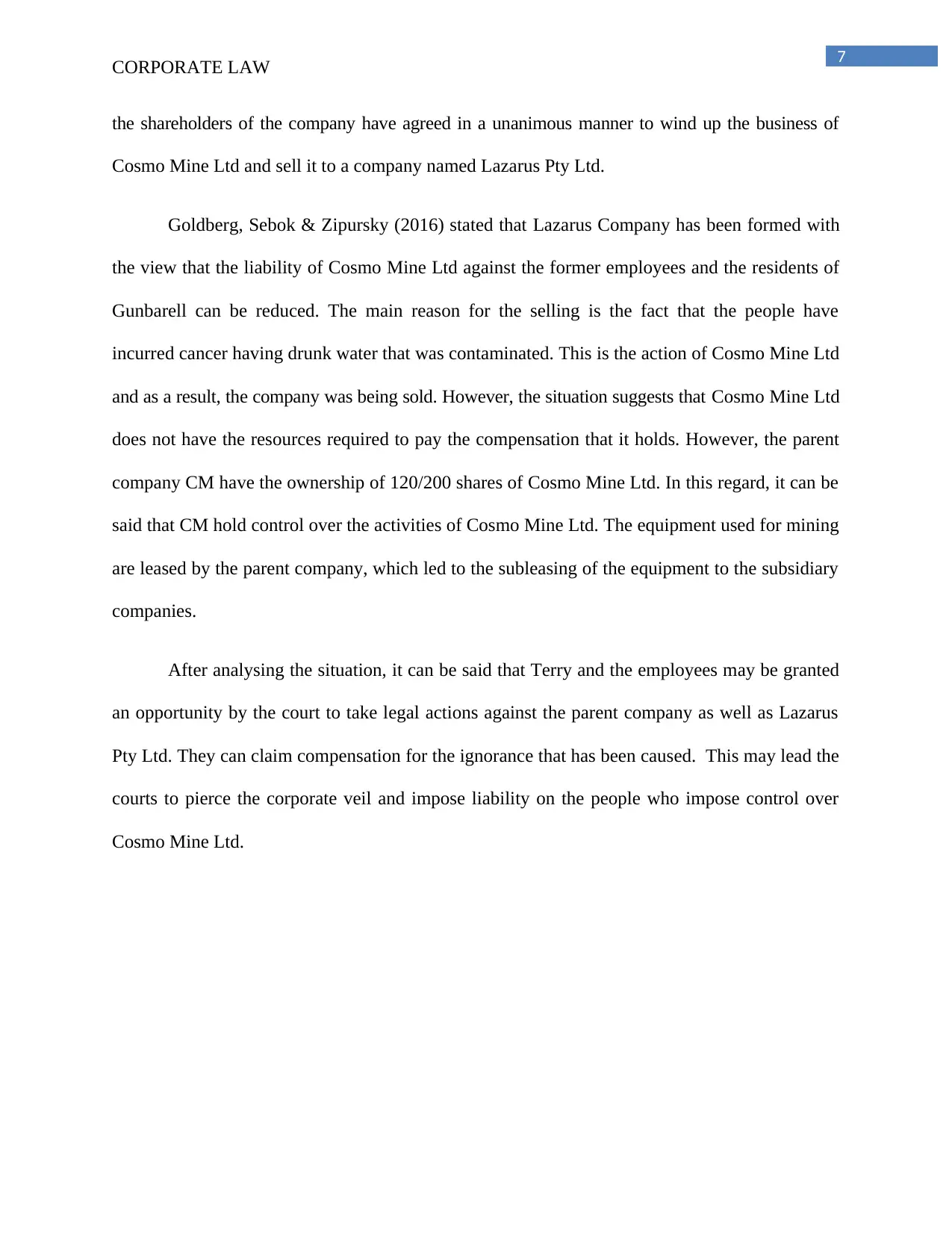
7
CORPORATE LAW
the shareholders of the company have agreed in a unanimous manner to wind up the business of
Cosmo Mine Ltd and sell it to a company named Lazarus Pty Ltd.
Goldberg, Sebok & Zipursky (2016) stated that Lazarus Company has been formed with
the view that the liability of Cosmo Mine Ltd against the former employees and the residents of
Gunbarell can be reduced. The main reason for the selling is the fact that the people have
incurred cancer having drunk water that was contaminated. This is the action of Cosmo Mine Ltd
and as a result, the company was being sold. However, the situation suggests that Cosmo Mine Ltd
does not have the resources required to pay the compensation that it holds. However, the parent
company CM have the ownership of 120/200 shares of Cosmo Mine Ltd. In this regard, it can be
said that CM hold control over the activities of Cosmo Mine Ltd. The equipment used for mining
are leased by the parent company, which led to the subleasing of the equipment to the subsidiary
companies.
After analysing the situation, it can be said that Terry and the employees may be granted
an opportunity by the court to take legal actions against the parent company as well as Lazarus
Pty Ltd. They can claim compensation for the ignorance that has been caused. This may lead the
courts to pierce the corporate veil and impose liability on the people who impose control over
Cosmo Mine Ltd.
CORPORATE LAW
the shareholders of the company have agreed in a unanimous manner to wind up the business of
Cosmo Mine Ltd and sell it to a company named Lazarus Pty Ltd.
Goldberg, Sebok & Zipursky (2016) stated that Lazarus Company has been formed with
the view that the liability of Cosmo Mine Ltd against the former employees and the residents of
Gunbarell can be reduced. The main reason for the selling is the fact that the people have
incurred cancer having drunk water that was contaminated. This is the action of Cosmo Mine Ltd
and as a result, the company was being sold. However, the situation suggests that Cosmo Mine Ltd
does not have the resources required to pay the compensation that it holds. However, the parent
company CM have the ownership of 120/200 shares of Cosmo Mine Ltd. In this regard, it can be
said that CM hold control over the activities of Cosmo Mine Ltd. The equipment used for mining
are leased by the parent company, which led to the subleasing of the equipment to the subsidiary
companies.
After analysing the situation, it can be said that Terry and the employees may be granted
an opportunity by the court to take legal actions against the parent company as well as Lazarus
Pty Ltd. They can claim compensation for the ignorance that has been caused. This may lead the
courts to pierce the corporate veil and impose liability on the people who impose control over
Cosmo Mine Ltd.
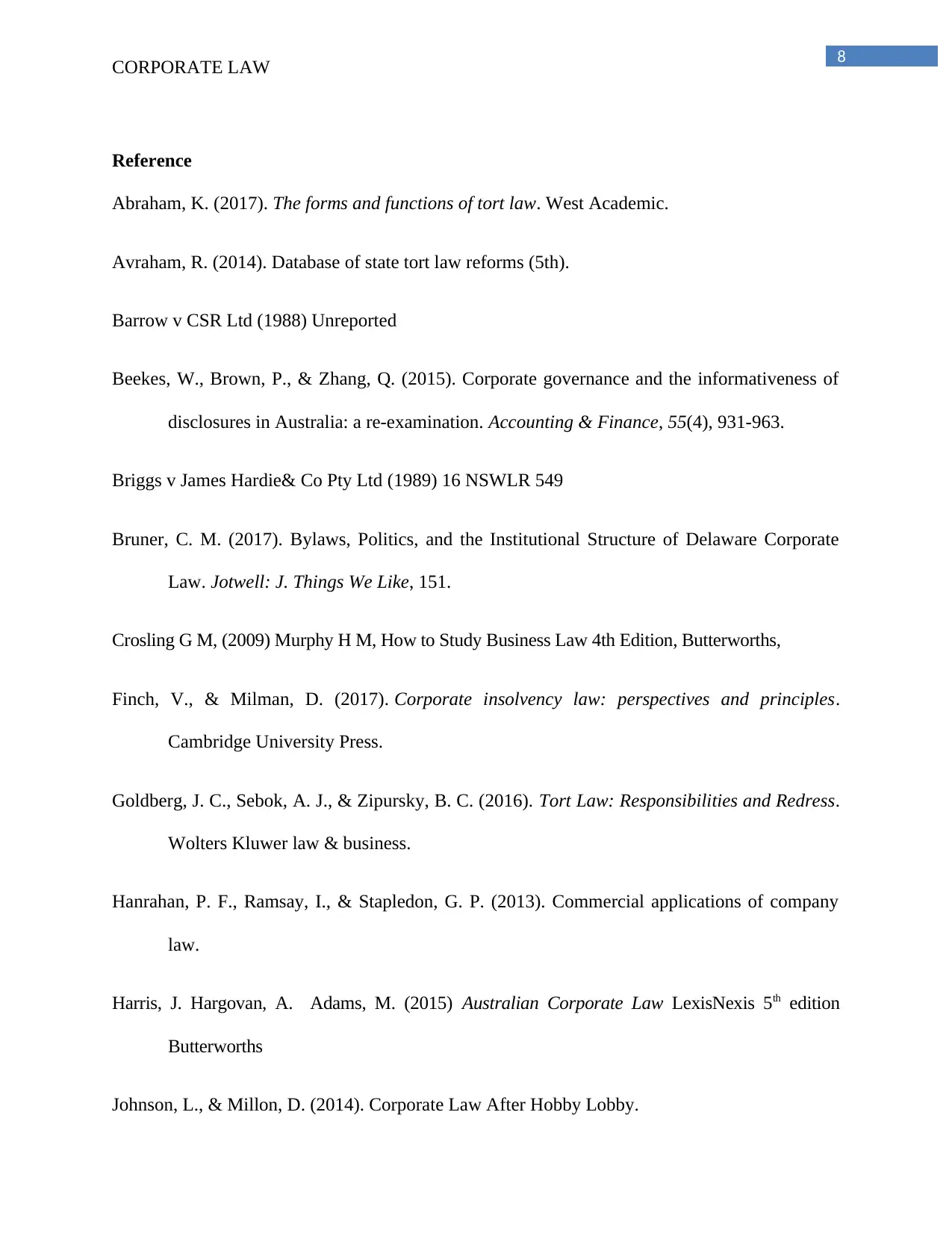
8
CORPORATE LAW
Reference
Abraham, K. (2017). The forms and functions of tort law. West Academic.
Avraham, R. (2014). Database of state tort law reforms (5th).
Barrow v CSR Ltd (1988) Unreported
Beekes, W., Brown, P., & Zhang, Q. (2015). Corporate governance and the informativeness of
disclosures in Australia: a re‐examination. Accounting & Finance, 55(4), 931-963.
Briggs v James Hardie& Co Pty Ltd (1989) 16 NSWLR 549
Bruner, C. M. (2017). Bylaws, Politics, and the Institutional Structure of Delaware Corporate
Law. Jotwell: J. Things We Like, 151.
Crosling G M, (2009) Murphy H M, How to Study Business Law 4th Edition, Butterworths,
Finch, V., & Milman, D. (2017). Corporate insolvency law: perspectives and principles.
Cambridge University Press.
Goldberg, J. C., Sebok, A. J., & Zipursky, B. C. (2016). Tort Law: Responsibilities and Redress.
Wolters Kluwer law & business.
Hanrahan, P. F., Ramsay, I., & Stapledon, G. P. (2013). Commercial applications of company
law.
Harris, J. Hargovan, A. Adams, M. (2015) Australian Corporate Law LexisNexis 5th edition
Butterworths
Johnson, L., & Millon, D. (2014). Corporate Law After Hobby Lobby.
CORPORATE LAW
Reference
Abraham, K. (2017). The forms and functions of tort law. West Academic.
Avraham, R. (2014). Database of state tort law reforms (5th).
Barrow v CSR Ltd (1988) Unreported
Beekes, W., Brown, P., & Zhang, Q. (2015). Corporate governance and the informativeness of
disclosures in Australia: a re‐examination. Accounting & Finance, 55(4), 931-963.
Briggs v James Hardie& Co Pty Ltd (1989) 16 NSWLR 549
Bruner, C. M. (2017). Bylaws, Politics, and the Institutional Structure of Delaware Corporate
Law. Jotwell: J. Things We Like, 151.
Crosling G M, (2009) Murphy H M, How to Study Business Law 4th Edition, Butterworths,
Finch, V., & Milman, D. (2017). Corporate insolvency law: perspectives and principles.
Cambridge University Press.
Goldberg, J. C., Sebok, A. J., & Zipursky, B. C. (2016). Tort Law: Responsibilities and Redress.
Wolters Kluwer law & business.
Hanrahan, P. F., Ramsay, I., & Stapledon, G. P. (2013). Commercial applications of company
law.
Harris, J. Hargovan, A. Adams, M. (2015) Australian Corporate Law LexisNexis 5th edition
Butterworths
Johnson, L., & Millon, D. (2014). Corporate Law After Hobby Lobby.
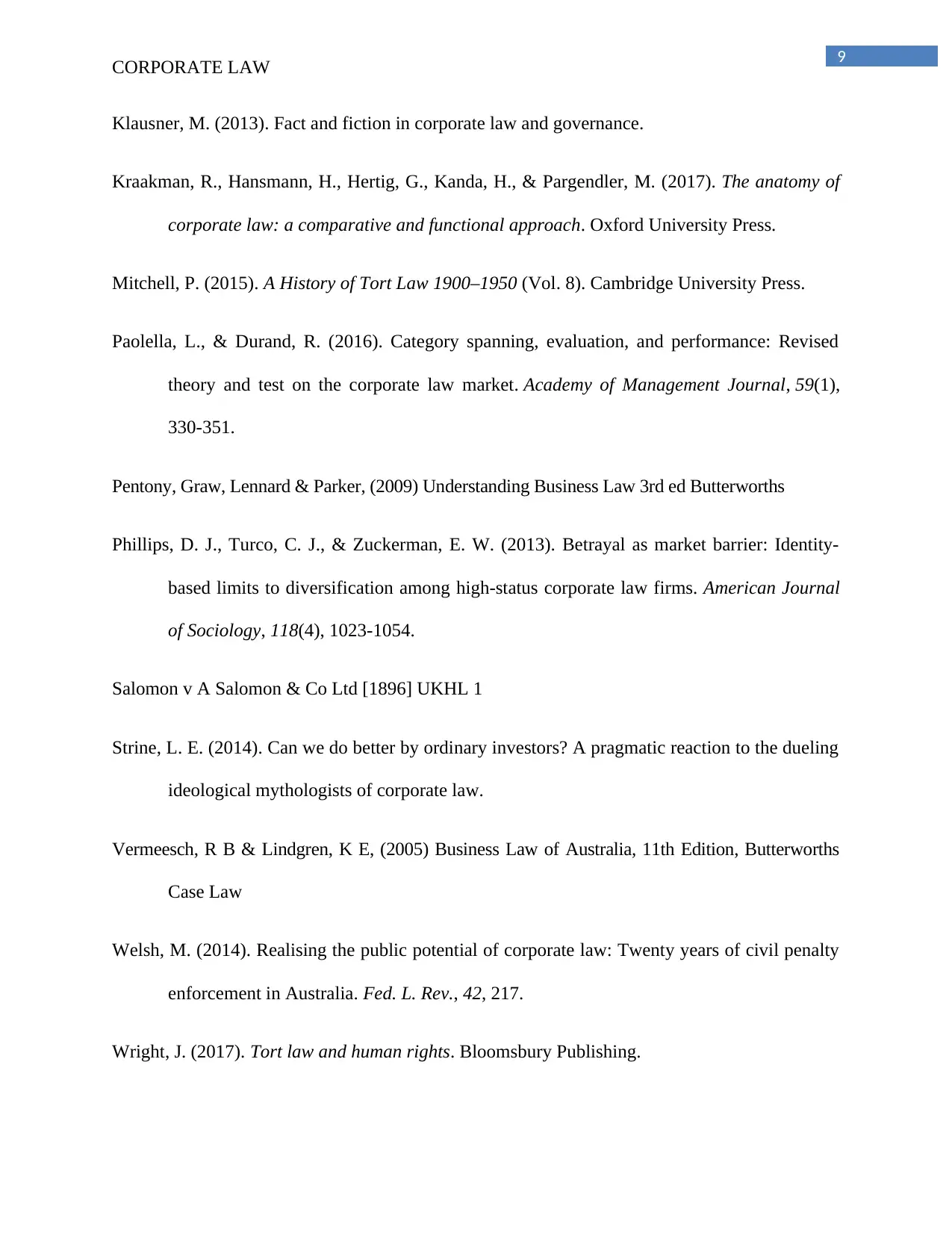
9
CORPORATE LAW
Klausner, M. (2013). Fact and fiction in corporate law and governance.
Kraakman, R., Hansmann, H., Hertig, G., Kanda, H., & Pargendler, M. (2017). The anatomy of
corporate law: a comparative and functional approach. Oxford University Press.
Mitchell, P. (2015). A History of Tort Law 1900–1950 (Vol. 8). Cambridge University Press.
Paolella, L., & Durand, R. (2016). Category spanning, evaluation, and performance: Revised
theory and test on the corporate law market. Academy of Management Journal, 59(1),
330-351.
Pentony, Graw, Lennard & Parker, (2009) Understanding Business Law 3rd ed Butterworths
Phillips, D. J., Turco, C. J., & Zuckerman, E. W. (2013). Betrayal as market barrier: Identity-
based limits to diversification among high-status corporate law firms. American Journal
of Sociology, 118(4), 1023-1054.
Salomon v A Salomon & Co Ltd [1896] UKHL 1
Strine, L. E. (2014). Can we do better by ordinary investors? A pragmatic reaction to the dueling
ideological mythologists of corporate law.
Vermeesch, R B & Lindgren, K E, (2005) Business Law of Australia, 11th Edition, Butterworths
Case Law
Welsh, M. (2014). Realising the public potential of corporate law: Twenty years of civil penalty
enforcement in Australia. Fed. L. Rev., 42, 217.
Wright, J. (2017). Tort law and human rights. Bloomsbury Publishing.
CORPORATE LAW
Klausner, M. (2013). Fact and fiction in corporate law and governance.
Kraakman, R., Hansmann, H., Hertig, G., Kanda, H., & Pargendler, M. (2017). The anatomy of
corporate law: a comparative and functional approach. Oxford University Press.
Mitchell, P. (2015). A History of Tort Law 1900–1950 (Vol. 8). Cambridge University Press.
Paolella, L., & Durand, R. (2016). Category spanning, evaluation, and performance: Revised
theory and test on the corporate law market. Academy of Management Journal, 59(1),
330-351.
Pentony, Graw, Lennard & Parker, (2009) Understanding Business Law 3rd ed Butterworths
Phillips, D. J., Turco, C. J., & Zuckerman, E. W. (2013). Betrayal as market barrier: Identity-
based limits to diversification among high-status corporate law firms. American Journal
of Sociology, 118(4), 1023-1054.
Salomon v A Salomon & Co Ltd [1896] UKHL 1
Strine, L. E. (2014). Can we do better by ordinary investors? A pragmatic reaction to the dueling
ideological mythologists of corporate law.
Vermeesch, R B & Lindgren, K E, (2005) Business Law of Australia, 11th Edition, Butterworths
Case Law
Welsh, M. (2014). Realising the public potential of corporate law: Twenty years of civil penalty
enforcement in Australia. Fed. L. Rev., 42, 217.
Wright, J. (2017). Tort law and human rights. Bloomsbury Publishing.
1 out of 10
Related Documents
Your All-in-One AI-Powered Toolkit for Academic Success.
+13062052269
info@desklib.com
Available 24*7 on WhatsApp / Email
![[object Object]](/_next/static/media/star-bottom.7253800d.svg)
Unlock your academic potential
© 2024 | Zucol Services PVT LTD | All rights reserved.





